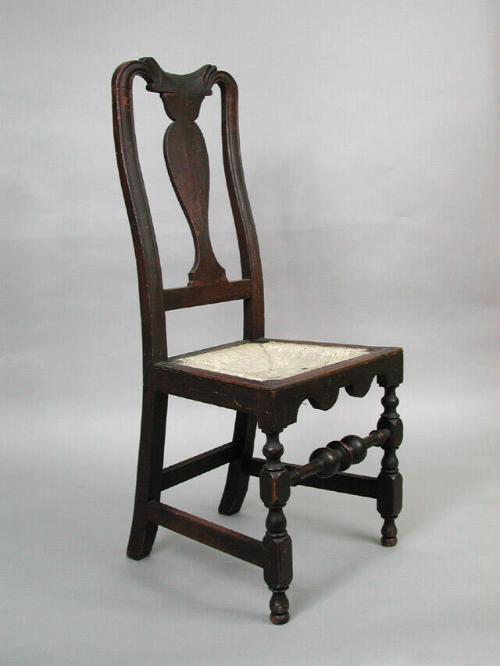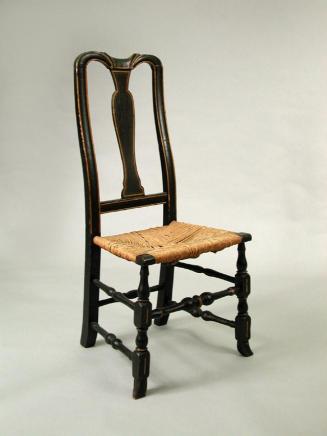Side Chair
Original OwnerOriginally owned by
General Andrew Ward V
(1727-1799)
Furniture MakerMade by
Unknown
Date1740-1760
MediumMaple, rush
DimensionsPrimary Dimensions (overall height x width x depth): 27 7/8 x 18 9/16 x 18 1/4in. (70.8 x 47.1 x 46.4cm)
ClassificationsFurniture
Credit LineMuseum purchase
Object number1987.63.0
DescriptionMaple side chair in the Queen Anne, or late baroque style, with a yoke-shaped crest rail, a vase-shaped splat, turned front legs and front stretcher, and a rush slip seat. The back of the chair is formed by a yoke-shaped crest rail atop two stiles. The crest rail bows down in the center and has a deeply beveled ridge at either side. Centered below the crest rail is a solid, vase-shaped splat, which attaches at the bottom to the stay rail. The bottom front edge of the stay rail is molded with a cyma curve, or S-curve. Each stile has a molded front, consisting of a projecting semi-circle with a bead to either side; this molding extends from the arched sides of the crest rail down to just above the level of the seat. Above the seat, each stile curves backward. Below the seat, each stile slants backward, over a foot that slants back even further. The rush seat is trapezoidal in shape. The front and side rails each have a molded top surface, consisting of a projecting semi-circle flanked by a bead. Each front corner of the seat is supported by a block at the top of the front leg. The front skirt between these blocks has a molded lower edge, consisting of a horizontal in the center with a deep cyma curve to each side. Each front leg is turned with a sequence of baluster, ring, block, baluster, ring, block, over a baluster-and-ring form foot. The front stretcher connecting the two front legs is turned with double-ball-and-ring forms. Both sides and the back each have one rectangular stretcher.
Condition: The rush is bowed down in the center of the seat and is painted white; portions of the white paint at the front edge are loose. The splat has split slightly in four locations at the front. A portion of the lower right side of the crest rail and the top of the right stile have both split and been repaired with wooden pins or nails through the top. The chair had an upholstered slip seat at one time.
Design and Construction Details: The crest rail is supported by a tenon at the top of each stile; each of these joint is secured with a wooden pin. The splat is tenoned into the crest rail above and into the stay rail below. The stay rail and back seat rail are tenoned to each stile. Each side seat rail and the front skirt are tenoned and pinned into the stile or the front leg. The top surface of the rush slip seat has been painted white. The frame of the rush slip seat has a block at each corner. Each of the slip seat rails is blade-like, with a rounded outer edge and a tapered inner edge. The slip seat frame is held in place in the chair frame by trim strips, or strips of wood, at the top of the side seat rails, the front legs, and the front skirt. These strips of wood are molded and nailed in place. Additionally, a strip of wood is nailed to the interior back of the back seat rail; this also provides support for the seat. The side stretchers are tenoned and pinned into the front and back legs. The front stretcher is tenoned into the front legs. The back stretcher is tenoned into the back legs.
NotesHistorical Note: This chair was probably one of the "6 swayback chairs" listed in the probate inventory of the original owner, Andrew Ward V (1727-1799).Condition: The rush is bowed down in the center of the seat and is painted white; portions of the white paint at the front edge are loose. The splat has split slightly in four locations at the front. A portion of the lower right side of the crest rail and the top of the right stile have both split and been repaired with wooden pins or nails through the top. The chair had an upholstered slip seat at one time.
Design and Construction Details: The crest rail is supported by a tenon at the top of each stile; each of these joint is secured with a wooden pin. The splat is tenoned into the crest rail above and into the stay rail below. The stay rail and back seat rail are tenoned to each stile. Each side seat rail and the front skirt are tenoned and pinned into the stile or the front leg. The top surface of the rush slip seat has been painted white. The frame of the rush slip seat has a block at each corner. Each of the slip seat rails is blade-like, with a rounded outer edge and a tapered inner edge. The slip seat frame is held in place in the chair frame by trim strips, or strips of wood, at the top of the side seat rails, the front legs, and the front skirt. These strips of wood are molded and nailed in place. Additionally, a strip of wood is nailed to the interior back of the back seat rail; this also provides support for the seat. The side stretchers are tenoned and pinned into the front and back legs. The front stretcher is tenoned into the front legs. The back stretcher is tenoned into the back legs.
Status
Not on view












